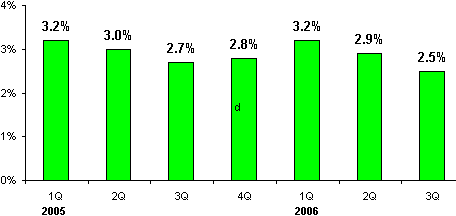Canada’s Economy Starts to Show Fatigue
December 05, 06 by Ken Gassman
Canada’s economy continues to expand, but the pace of growth is slowing notably, reflecting the advanced age of the current business cycle. On a year-over-year basis, the Canadian economy grew at a reasonable pace – +2.5 percent – during the three months ended September 2006, but this growth rate was down from prior quarters.
Canada, a major rough diamond producer, consumes just under 2 percent of the world’s jewelry and diamonds. It is a minor market in overall global consumer demand for jewelry.
| Canada - Real GDP Growth
By Quarter

Source: StatCanad |
Private Spending Up, Government Spending Down
In the third quarter ended September 2006, personal consumption, exports, and business investment were the primary drivers of growth of the Canadian economy. Government spending slowed considerably, and inventory accumulation was negative.
The expansion of Canada’s export economy was solid and widespread in the September quarter. Agricultural exports, machinery and equipment, and industrial goods drove exports higher. The Canadian dollar (the one dollar coin colloquially called the ‘Loonie’), slipped modestly against the U.S. dollar in the third quarter; this took some pressure off of exporters who had seen a slowdown in demand from U.S. importers unwilling to pay higher prices due to a more valuable Canadian dollar.
The housing market in Canada has begun to show signs of stress. After a five-year expansion, demand has cooled notably. New homebuilding slipped 3.3 percent in the September quarter. However, consumers have not totally abandoned their demand for homes, according to analysts. Further, remodeling activity advanced in the third quarter.
Looking ahead, Canada’s export of energy products will be one of the few categories to help keep this country’s economy from slipping into a recession, since global demand for Canadian oil will remain firm. Export demand from Canada’s largest trading partner, the U.S., could soften in 2007, as the U.S. economy cools. Thus, consumer spending may slow as the labor market stabilizes. Further, with tax revenues growing more slowly, government spending will not add growth.

